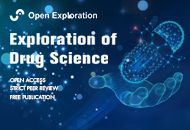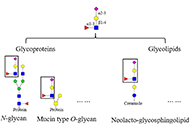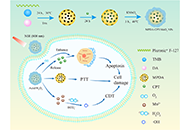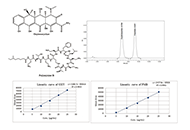Essential functions, syntheses and detection of sialyl Lewis X on glycoproteins
It is widely acknowledged that sialyl Lewis X (sLeX), the composition and linkage of which are N-acetylneuraminic acid (Neu5Ac) α2-3 galactose (Gal) β1-4 [fucose (Fuc) α1-3] N-acetylglucosamine, is usually attached to the cell
[...] Read more.
It is widely acknowledged that sialyl Lewis X (sLeX), the composition and linkage of which are N-acetylneuraminic acid (Neu5Ac) α2-3 galactose (Gal) β1-4 [fucose (Fuc) α1-3] N-acetylglucosamine, is usually attached to the cell surface. It presents as a terminal structure on either glycoproteins or glycolipids and has been demonstrated to be related to various biological processes, such as fertilization and selectin binding. Due to the vital role of sLeX, its synthesis as well as its determination approaches have attracted considerable attention from many researchers. In this review, the focus is sLeX on glycoproteins. The biological importance of sLeX in fertilization and development, immunity, cancers, and other aspects will be first introduced. Then the chemical and enzymatic synthesis of sLeX including the contributions from more than 15 international research groups will be described, followed by a brief view of the sLeX detection focusing on monosaccharides and linkages. This review is valuable for those readers who are interested in the chemistry and biology of sLeX.
Qiushi Chen ... Xuechen Li
It is widely acknowledged that sialyl Lewis X (sLeX), the composition and linkage of which are N-acetylneuraminic acid (Neu5Ac) α2-3 galactose (Gal) β1-4 [fucose (Fuc) α1-3] N-acetylglucosamine, is usually attached to the cell surface. It presents as a terminal structure on either glycoproteins or glycolipids and has been demonstrated to be related to various biological processes, such as fertilization and selectin binding. Due to the vital role of sLeX, its synthesis as well as its determination approaches have attracted considerable attention from many researchers. In this review, the focus is sLeX on glycoproteins. The biological importance of sLeX in fertilization and development, immunity, cancers, and other aspects will be first introduced. Then the chemical and enzymatic synthesis of sLeX including the contributions from more than 15 international research groups will be described, followed by a brief view of the sLeX detection focusing on monosaccharides and linkages. This review is valuable for those readers who are interested in the chemistry and biology of sLeX.
 Utilizing the Ethereum blockchain for retrieving and archiving augmented reality surgical navigation dataOpen AccessSystematic ReviewAim: Conventional techniques to share and archive spinal imaging data raise issues with trust and security, with novel approaches being more greatly considered. Ethereum smart contracts present o [...] Read more.Sai Batchu ... Brandon Lucke-WoldPublished: February 28, 2023 Explor Drug Sci. 2023;1:55–63
Utilizing the Ethereum blockchain for retrieving and archiving augmented reality surgical navigation dataOpen AccessSystematic ReviewAim: Conventional techniques to share and archive spinal imaging data raise issues with trust and security, with novel approaches being more greatly considered. Ethereum smart contracts present o [...] Read more.Sai Batchu ... Brandon Lucke-WoldPublished: February 28, 2023 Explor Drug Sci. 2023;1:55–63 Essential functions, syntheses and detection of sialyl Lewis X on glycoproteinsOpen AccessReviewIt is widely acknowledged that sialyl Lewis X (sLeX), the composition and linkage of which are N-acetylneuraminic acid (Neu5Ac) α2-3 galactose (Gal) β1-4 [fucose (Fuc) α1-3] N-acetylglucosamine, is usually attached to the cell [...] Read more.Qiushi Chen ... Xuechen LiPublished: February 28, 2023 Explor Drug Sci. 2023;1:31–54
Essential functions, syntheses and detection of sialyl Lewis X on glycoproteinsOpen AccessReviewIt is widely acknowledged that sialyl Lewis X (sLeX), the composition and linkage of which are N-acetylneuraminic acid (Neu5Ac) α2-3 galactose (Gal) β1-4 [fucose (Fuc) α1-3] N-acetylglucosamine, is usually attached to the cell [...] Read more.Qiushi Chen ... Xuechen LiPublished: February 28, 2023 Explor Drug Sci. 2023;1:31–54 Surface functionalized mesoporous polydopamine nanocomposites for killing tumor cells through collaborative chemo/photothermal/chemodynamic treatmentOpen AccessOriginal ArticleAim: The development of a collaborative strategy with improved efficacy holds great promise in tumor treatment. This study aims to develop an effective collaborative strategy based on functionalized mesoporous polydopamine (MPDA) [...] Read more.Yi Ouyang ... Hui LiuPublished: February 27, 2023 Explor Drug Sci. 2023;1:18–30
Surface functionalized mesoporous polydopamine nanocomposites for killing tumor cells through collaborative chemo/photothermal/chemodynamic treatmentOpen AccessOriginal ArticleAim: The development of a collaborative strategy with improved efficacy holds great promise in tumor treatment. This study aims to develop an effective collaborative strategy based on functionalized mesoporous polydopamine (MPDA) [...] Read more.Yi Ouyang ... Hui LiuPublished: February 27, 2023 Explor Drug Sci. 2023;1:18–30 Convenient estimation of oxytetracycline and polymyxin B by a novel high-performance liquid chromatography method: development and validationOpen AccessOriginal ArticleAim: The aim of this research work was to develop a validated reversed-phase (RP)-high-performance liquid chromatography (HPLC) method for simultaneous estimation of oxytetracycline (OXY) and pol [...] Read more.Tanu Chaudhary ... Dilpreet SinghPublished: February 24, 2023 Explor Drug Sci. 2023;1:6–17
Convenient estimation of oxytetracycline and polymyxin B by a novel high-performance liquid chromatography method: development and validationOpen AccessOriginal ArticleAim: The aim of this research work was to develop a validated reversed-phase (RP)-high-performance liquid chromatography (HPLC) method for simultaneous estimation of oxytetracycline (OXY) and pol [...] Read more.Tanu Chaudhary ... Dilpreet SinghPublished: February 24, 2023 Explor Drug Sci. 2023;1:6–17 Drug discovery: a multifactorial ecosystemOpen AccessEditorialFernando AlbericioPublished: January 01, 2023 Explor Drug Sci. 2023;1:1–5
Drug discovery: a multifactorial ecosystemOpen AccessEditorialFernando AlbericioPublished: January 01, 2023 Explor Drug Sci. 2023;1:1–5